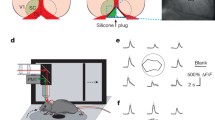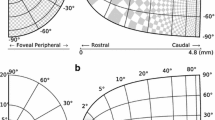Abstract
The superior colliculus (SC) integrates relevant sensory information (visual, auditory, somatosensory) from several cortical and subcortical structures, to program orientation responses to external events. However, this capacity is not present at birth, and it is acquired only through interactions with cross-modal events during maturation. Mathematical models provide a quantitative framework, valuable in helping to clarify the specific neural mechanisms underlying the maturation of the multisensory integration in the SC. We extended a neural network model of the adult SC (Cuppini et al., Front Integr Neurosci 4:1–15, 2010) to describe the development of this phenomenon starting from an immature state, based on known or suspected anatomy and physiology, in which: (1) AES afferents are present but weak, (2) Responses are driven from non-AES afferents, and (3) The visual inputs have a marginal spatial tuning. Sensory experience was modeled by repeatedly presenting modality-specific and cross-modal stimuli. Synapses in the network were modified by simple Hebbian learning rules. As a consequence of this exposure, (1) Receptive fields shrink and come into spatial register, and (2) SC neurons gained the adult characteristic integrative properties: enhancement, depression, and inverse effectiveness. Importantly, the unique architecture of the model guided the development so that integration became dependent on the relationship between the cortical input and the SC. Manipulations of the statistics of the experience during the development changed the integrative profiles of the neurons, and results matched well with the results of physiological studies.
Similar content being viewed by others
References
Alvarado JC, Stanford TR, Vaughan JW, Stein BE (2007) Cortex Mediates Multisensory But Not Unisensory Integration in Superior Colliculus. J Neurosci 27: 12775–12786
Alvarado JC, Rowland BA, Stanford TR, Stein BE (2008) A neural network model of multisensory integration also accounts for unisensory integration in superior colliculus. Brain Res 1242: 13–23
Alvarado JC, Stanford TR, Rowland BA, Vaughan JW, Stein BE (2009) Multisensory Integration in the Superior Colliculus Requires Synergy among Corticocollicular Inputs. J Neurosci 29: 6580–6592
Anastasio TJ, Patton PE (2003) A two-stage unsupervised learning algorithm reproduces multisensory enhancement in a neural network model of the corticotectal system. J Neurosci 23: 6713–6727
Anastasio TJ, Patton PE, Belkacem-Boussaid K (2000) Using Bayes rule to model multisensory enhancement in the superior colliculus. Neural Comput 12: 1165–1187
Colonius H, Diederich A (2004) Why aren’t all deep superior colliculus neurons multisensory? A Bayes’ ratio analysis. Cogn Affect Behav Neurosci 4: 344–353
Cuppini C, Ursino M, Magosso E, Rowland BA, Stein BE (2010) An emergent model of multisensory integration in superior colliculus neurons. Front Integr Neurosci 4: 1–15
Cuppini C, Stein B, Rowland B, Magosso E, Ursino M (2011) A computational study of multisensory maturation in the superior colliculus (SC). Exp Brain Res 213: 341–349
Fuentes-Santamaria V, Alvarado JC, McHaffie JG, Stein BE (2009) Axon morphologies and convergence patterns of projections from different sensory-specific cortices of the anterior ectosylvian sulcus onto multisensory neurons in the cat superior colliculus. Cereb Cortex 19: 2902–2915
Holmes NP, Spence C (2005) Multisensory integration: space, time and superadditivity. Curr Biol 15: R762–R764
Jiang W, Wallace MT, Jiang H, Vaughan JW, Stein BE (2001) Two cortical areas mediate multisensory integration in superior colliculus neurons. J Neurophysiol 85: 506–522
Jiang W, Jiang H, Stein BE (2002) Two corticotectal areas facilitate multisensory orientation behavior. J Cogn Neurosci 14: 1240–1255
Jiang W, Jiang H, Stein BE (2006) Neonatal cortical ablation disrupts multisensory development in superior colliculus. J Neurophysiol 95: 1380–1396
Jiang W, Jiang H, Rowland BA, Stein BE (2007) Multisensory orientation behavior is disrupted by neonatal cortical ablation. J Neurophysiol 97: 557–562
Kadunce DC, Vaughan JW, Wallace MT, Benedek G, Stein BE (1997) Mechanisms of within- and cross-modality suppression in the superior colliculus. J Neurophysiol 78: 2834–2847
Kadunce DC, Vaughan JW, Wallace MT, Stein BE (2001) The influence of visual and auditory receptive field organization on multisensory integration in the superior colliculus. Exp Brain Res 139: 303–310
Koch C (1998) Biophysics of computation: information processing in single neurons. Oxford University Press, New York
Magosso E, Cuppini C, Serino A, Di Pellegrino G, Ursino M (2008) A theoretical study of multisensory integration in the superior colliculus by a neural network model. Neural Netw 21: 817–829
Maruff P, Yucel M, Danckert J, Stuart G, Currie J (1999) Facilitation and inhibition arising from the exogenous orienting of covert attention depends on the temporal properties of spatial cues and targets. Neuropsychologia 37: 731–744
Meredith MA, Stein BE (1986) Visual, auditory, and somatosensory convergence on cells in superior colliculus results in multisensory integration. J Neurophysiol 56: 640–662
Meredith MA, Nemitz JW, Stein BE (1987) Determinants of multisensory integration in superior colliculus neurons. I. Temporal factors. J Neurosci 7: 3215–3229
Meredith MA, Stein BE (1996) Spatial determinants of multisensory integration in cat superior colliculus neurons. J Neurophysiol 75: 1843–1857
Ohshiro T, Angelaki DE, DeAngelis GC (2011) A normalization model of multisensory integration. Nat Neurosci 14: 775–782
Patton PE, Anastasio TJ (2003) Modelling cross-modal enhancement and modality-specific suppression in multisensory neurons. Neural Comput 15: 783–810
Patton PE, Belkacem-Boussaid K, Anastasio TJ (2002) Multimodality in the superior colliculus: an information theoretic analysis. Brain Res Cogn Brain Res 14: 10–19
Rowland BA, Stanford TR, Stein BE (2007) A model of the neural mechanisms underlying multisensory integration in the superior colliculus. Perception 36: 1431–1443
Stein BE, Meredith MA (1990) Multisensory integration. Neural and behavioral solutions for dealing with stimuli from different sensory modalities. Ann N Y Acad Sci 608: 51–70
Stein BE, Meredith MA (1993) The merging of the senses. MIT Press, Cambridge, MA
Stein BE, Labos E, Kruger L (1973a) Sequence of changes in properties of neurons of superior colliculus of the kitten during maturation. J Neurophysiol 36: 667–679
Stein BE, Labos E, Kruger L (1973b) Determinants of response latency in neurons of superior colliculus in kittens. J Neurophysiol 36: 680–689
Ursino M, Cuppini C, Magosso E, Serino A, Di Pellegrino G (2009) Multisensory integration in the superior colliculus: a neural network model. J Comput Neurosci 26: 55–73
Wallace MT, Stein BE (1994) Cross-modal synthesis in the midbrain depends on input from cortex. J Neurophysiol 71: 429–432
Wallace MT, Stein BE (1997) Development of multisensory neurons and multisensory integration in cat superior colliculus. J Neurosci 17: 2429–2444
Wallace MT, Stein BE (2000) Onset of cross-modal synthesis in the neonatal superior colliculus is gated by the development of cortical influences. J Neurophysiol 83: 3578–3582
Wallace MT, Stein BE (2001) Sensory and multisensory responses in the newborn monkey superior colliculus. J Neurosci 21: 8886–8894
Wallace MT, Stein BE (2007) Early experience determines how the senses will interact. J Neurophysiol 97: 921–926
Wallace MT, Perrault TJ Jr, Hairston WD, Stein BE (2004) Visual experience is necessary for the development of multisensory integration. J Neurosci 24: 9580–9584
Wallace MT, Carriere BN, Perrault TJ Jr, Vaughan JW, Stein BE (2006) The development of cortical multisensory integration. J Neurosci 26: 11844–11849
Yu L, Rowland BA, Stein BE (2010) Initiating the development of multisensory integration by manipulating sensory experience. J Neurosci 30: 4904–4913
Author information
Authors and Affiliations
Corresponding author
Rights and permissions
About this article
Cite this article
Cuppini, C., Magosso, E., Rowland, B. et al. Hebbian mechanisms help explain development of multisensory integration in the superior colliculus: a neural network model. Biol Cybern 106, 691–713 (2012). https://doi.org/10.1007/s00422-012-0511-9
Received:
Accepted:
Published:
Issue Date:
DOI: https://doi.org/10.1007/s00422-012-0511-9




